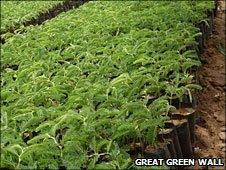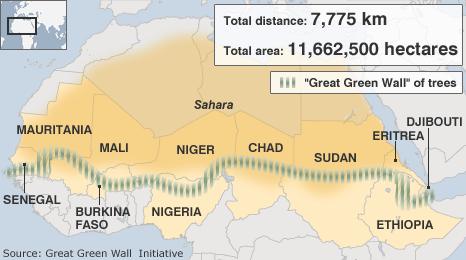Push for 'Great Green Wall of Africa' to halt Sahara
- Published

Drought-resistant trees would be needed to survive in some parts
African leaders are meeting in Chad to push the idea of planting a tree belt across Africa from Senegal in the west to Djibouti in the east.
The Great Green Wall project is backed by the African Union and is aimed at halting the advancing Sahara Desert.
The belt would be 15km (nine miles) wide and 7,775km (4,831 miles) long.
The initiative, conceived five years ago, has not started because of a lack of funding and some experts worry it would not be maintained properly.
The BBC's Tidiane Sy in Senegal says the initiative has the full backing of Senegalese President Abdoulaye Wade, who is in Chad with 10 other heads of state to discuss desertification.
His government has created the website dedicated to the Great Green Wall.
But our reporter says many other leaders seem ready to forget the project.
At the Copenhagen Climate Change summit last year, for instance, the Senegalese delegation made a presentation on the project.

It is envisaged that the belt would go through 11 countries from east to west.
The trees should be "drought-adapted species", preferably native to the areas planted, the Great Green Wall website says, listing 37 suitable species.
The initiative says it hopes the trees will slow soil erosion; slow wind speeds and help rain water filter into the ground, to stop the desert from growing.
It also says a richer soil content will help communities across the Sahel who depend on land for grazing and agriculture.
Senegal says it has spent about $2m (£1.35m) on it and communities are being encouraged to plant trees.
The BBC's former Chad correspondent Celeste Hicks says older people in N'Djamena - where the conference is being held - talk anecdotally about how the capital city has become a dustbowl over the last 20 years as the Sahara Desert has encroached southwards.
The country has made efforts to plant a green belt of trees around the capital, and tens of thousands of young trees are being grown in nurseries on the outskirts of the city, she says.
But so far little has been done to transplant these trees to the northern desert areas to become part of the Great Green Wall.